| Alaungdaw Kathapa National Park | |
|---|---|
 | |
 Location in Myanmar | |
| Location | Kani and Mingin Townships, Sagaing Division, Myanmar |
| Coordinates | 22°23′N 94°25′E / 22.383°N 94.417°E |
| Area | 541.6 sq mi (1,403 km2)[1] |
| Established | 21 July 1893 as Patolon Reserved Forest, 1941 as Alaungdaw Kathapa Wild Life Reserve |
| Governing body | Nature and Wildlife Conservation Division |
Alaungdaw Kathapa National Park is a national park in Myanmar covering 541.6 sq mi (1,403 km2). It was established in 1989 and is listed as one of the ASEAN Heritage Parks.[1] It spans an elevation of 443–4,380 ft (135–1,335 m) in the Kani and Mingin Townships in Sagaing Region.[2]
History
In 1893, this mountainous area between the Chindwin and Myittha Rivers was declared a reserved forest and selectively logged for teak. It was little disturbed when surveyors of the Food and Agriculture Organization and the United Nations Development Programme visited it in the early 1980s, who were invited by the Government of Myanmar to assist in identifying suitable areas for national parks and nature reserves. In 1984, they proposed to establish a tract of 1,606 km2 (620 sq mi) as Alaungdaw Kathapa National Park.[3] Its name honours a legendary monk who lived there in historical times. The national park was gazetted in 1989 and demarcated with an area of 617 km2 (238 sq mi).[2] Its actual area reported by Myanmar's Ministry of Natural Resources and Environmental Conservation is 541.6 km2 (209.1 sq mi).[1]
Biodiversity
Alaungdaw Kathapa National Park harbours foremost mixed deciduous forest, evergreen forest and pine forest with 165 tree species and 39 species of medicinal plants.[4]
Asian elephant (Elephas maximus), gaur (Bos gaurus), Himalayan black bear (Ursus thibetanus), sun bear (Helarctos malayanus), dhole (Cuon alpinus), sambar deer (Cervus unicolor), Indian muntjac (Muntiacus muntjak), wild boar (Sus scrofa), Indian crested porcupine (Hystrix indica) and black giant squirrel (Ratufa bicolor) were sighted during a transect survey in January 1999.[5] The elephant population was estimated at between two and 41 individuals in 2003, based on dung surveys conducted over three years.[6] Wildlife recorded during a camera trap survey in 1999 comprised yellow-throated marten (Martes flavigula), Asian palm civet (Paradoxurus hermaphroditus), large Indian civet (Viverra zibetha), small Indian civet (Viverricula indica), hog badger (Arctonyx collaris), crab-eating mongoose (Herpestes urva), leopard (Panthera pardus), Asiatic golden cat (Catopuma temminckii) and leopard cat (Prionailurus bengalensis).[7][8]
In 2000, the bent-toed gecko Cyrtodactylus annandalei was discovered in the national park and described as a new species in 2003. It is sympatric with Cyrtodactylus slowinskii.[9] Oriental leaf-toed gecko (Hemidactylus bowringii), Brooke's house gecko (H. brookii), common house gecko (H. frenatus), Indo-Pacific gecko (H. garnotii) and flat-tailed house gecko (H. platyurus) also live in the national park.[10]
References
- 1 2 3 World Database on Protected Areas (2019). "Alaungdaw Katthapa National Park". Protected Planet. Archived from the original on 7 December 2019. Retrieved 7 December 2019.
- 1 2 Beffasti, L.; Gallanti, V., eds. (2011). "Alaungdaw Kathapa" (PDF). Myanmar Protected Areas: Context, Current Status and Challenges. Milano, Yangon: Istituto Oikos, Biodiversity and Nature Conservation Association. pp. 22–23.
- ↑ Blower, J. (1985). "Conservation priorities in Burma". Oryx. 19 (2): 79–85. doi:10.1017/S0030605300019773.
- ↑ Oo, T. N.; Oo, L. K.; Kyi, Y. Y. (2006). Assessment on Plant Biodiversity of the Alaungdaw Kathapa National Park in Myanmar (PDF). Yangon: Government of the Union of Myanmar, Ministry of Forestry, Forest Department.
- ↑ Varma, S. (2009). "Diversity, conservation and management of mammals in Bago Yoma, Rakhine Yoma and Alaungdaw Kathapa National Park in Myanmar". Journal of the Bombay Natural History Society. 106 (3): 324–334.
- ↑ Leimgruber, P.; Oo, Z. M.; Aung, M.; Kelly, D. S.; Wemmer, C.; Senior, B.; Songer, M. (2011). "Current status of Asian elephants in Myanmar". Gajah. 35: 76–86. S2CID 38256840.
- ↑ Than Zaw; Saw Htun; Saw Htoo Tha Po; Myint Maung; Lynam, A. J.; Kyaw Thinn Latt; Duckworth, J. W. (2008). "Status and distribution of small carnivores in Myanmar". Small Carnivore Conservation. 38: 2–28.
- ↑ Than Zaw; Than Myint; Saw Htun; Saw Htoo Tha Po; Kyaw Thinn Latt; Myint Maung; Lynam A. J. (2014). "Status and distribution of smaller felids in Myanmar" (PDF). Cat News (Special Issue 8): 24–30.
- ↑ Bauer, A. M. (2003). "Descriptions of seven new Cyrtodactylus (Squamata: Gekkonidae) with a key to the species of Myanmar (Burma)". Proceedings of the California Academy of Sciences. 54 (25): 463–498. S2CID 129933095.
- ↑ Zug, G. R.; Vindum, J. V.; Koo, M. S. (2007). "Burmese Hemidactylus (Reptilia, Squamata, Gekkonidae): taxonomic notes on tropical Asian Hemidactylus". Proceedings of the California Academy of Sciences. 58 (19): 387–405.
External links
- BirdLife International (2019). "Important Bird Areas factsheet: Alaungdaw Kathapa".
- "Alaungdaw Kathapa National Park". Ministry of Hotels and Tourism, Department of Ecotourism. Archived from the original on 26 June 2009.